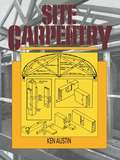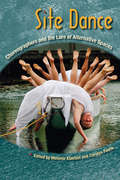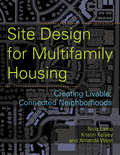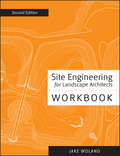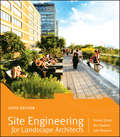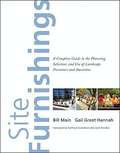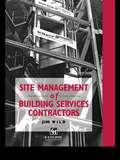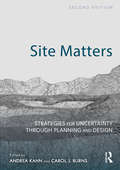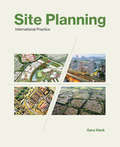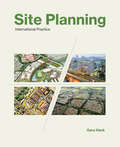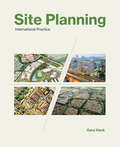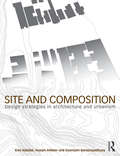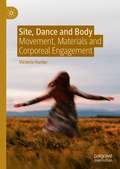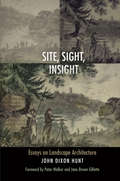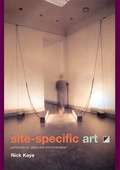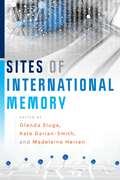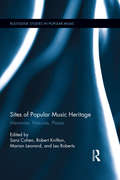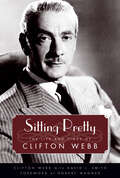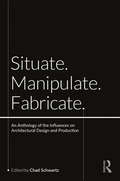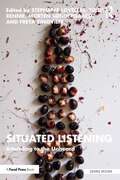- Table View
- List View
Site Analysis
by James A. LagroThe process-oriented guide to context-sensitive site selection, planning, and designSustainable design is responsive to context. And each site has a unique set of physical, biological, cultural, and legal attributes that presents different opportunities and constraints for alternative uses of the site. Site analysis systematically evaluates these on-site and off-site factors to inform the design of places-including neighborhoods and communities-that are attractive, walkable, and climate-resilient.This Third Edition of Site Analysis is fully updated to cover the latest topics in low-impact, location-efficient design and development.This complete, user-friendly guide:Blends theory andpractice from the fields of landscape architecture, urban planning, architecture, geography, and urban designAddresses important sustainability topics, including LEED-ND, Sustainable Sites, STAR community index, and climate adaptationDetails the objectives and visualization methods used in each phase of the site planning and design processExplains the influence of codes, ordinances, and site plan approval processes on the design of the built environmentIncludes more than 200 illustrations and eight case studies of projects completed by leading planning and design firmsSite Analysis, Third Edition is the ideal guide for students taking courses in site analysis, site planning, and environmental design. New material includes review questions at the end of each chapter for students as well as early-career professionals preparing for the ARE, LARE, or AICP exams.
Site Carpentry
by C.K. AustinThis book deals with sound craftsmanship utilising correct tools and materials. Practical advice on subjects such as framework, design and construction, timberfloor construction and arch centres.
Site Dance: Choreographers and the Lure of Alternative Spaces
by Melanie Kloetzel Carolyn PavlikIn recent years, site-specific dance has grown in popularity. In the wake of groundbreaking work by choreographers who left traditional performance spaces for other venues, more and more performances are cropping up on skyscrapers, in alleyways, on trains, on the decks of aircraft carriers, and in a myriad of other unexpected locations worldwide.In Site Dance, the first anthology to examine site-specific dance, editors Melanie Kloetzel and Carolyn Pavlik explore the work that choreographers create for nontraditional performance spaces and the thinking behind their creative choices. Combining interviews with and essays by some of the most prominent and influential practitioners of site dance, they look at the challenges and rewards of embracing alternative spaces. The close examinations of the work of artists like Meredith Monk, Joanna Haigood, Stephan Koplowitz, Heidi Duckler, Ann Carlson, and Eiko Otake provide important insights into why choreographers leave the theatre to embrace the challenges of unconventional venues.Site Dance also includes more than 80 photographs of site-specific performances, revealing how the arts, and movement in particular, can become part of and speak to our everyday lives. Celebrating the often unexpected beauty and juxtapositions created by site dance, the book is essential reading for anyone curious about the way that these choreographers are changing our experience of the world one step at a time.
Site Design for Multifamily Housing: Creating Livable, Connected Neighborhoods
by Nico Larco Kristin Kelsey Amanda WestThe United States is over eighty percent urbanized, yet over half of the population still lives in suburban settings, characterized by low-density, automobile-dependent development with separated land uses. These disconnected and isolated models of development have been linked to increased greenhouse-gas emissions and reduced quality of life, health, and social connections. In Site Design for Multifamily Housing: Creating Livable, Connected Neighborhoods, the authorsexplain that creating more livable and vital communities is within reach and the design and development of multifamily housing is a key component to reaching this goal. Multifamily housing is an important component of increasing density, but large lot multifamily developments often lack connectivity and hence limit livability and walkability. Multifamily housing in suburban areas presents greater challenges than in urban areas due in part to larger lot sizes and street patterns that are often a mix of cul-de-sac, curved, looped, and dead-end streets. Increasing the livability of these developments is an important first step in affecting the livability of the country as a whole. This handbook introduces planners, developers, and designers to ten key elements of multifamily site design, comparing typical and recommended conditions. Case studies of successful large lot multifamily developments as well as retrofit proposals for existing developments with low internal and external connectivity will demonstrate how the tools in the book can be applied. Examples are drawn from Oregon, California, North Carolina, and Arizona. The ideas and tools in this book, including theplanning checklist, code guide, and code summaries, will help users to create more livable, vibrant, and healthy communities.
Site Engineering Workbook
by Jake WolandA study guide to help you master the principles and practices of site engineeringWhether used in conjunction with the Sixth Edition of Site Engineering for Landscape Architects or on its own, this Workbook is an invaluable learning resource for students and instructors, as well as for professionals studying for the LARE and other licensing exams.Organized into chapters that correspond with those in the textbook, the Workbook offers:Practice questions, problems, and review exercises designed to reinforce site engineering conceptsSite and grading diagrams that make it possible to apply site engineering concepts in a practical wayFour types of questions-observations, short answer, long answer, and graphic exercises-that offer opportunities to approach the material from varied angles and levels of complexityAnswers to workbook problems, provided online via an instructor's siteDesigned for the needs of both students and professionals, this Workbook makes it easier than ever for you to quickly master the principles and practices involved in today's environmentally sound site engineering.
Site Engineering for Landscape Architects
by Jake Woland Kurt Nathan Steven StromThe Leading Guide To Site Design And Engineering- Revised And UpdatedSite Engineering for Landscape Architects is the top choice for site engineering, planning, and construction courses as well as for practitioners in the field, with easy-to-understand coverage of the principles and techniques of basic site engineering for grading, drainage, earthwork, and road alignment. The Sixth Edition has been revised to address the latest developments in landscape architecture while retaining an accessible approach to complex concepts.The book offers an introduction to landform and the language of its design, and explores the site engineering concepts essential to practicing landscape architecture today-from interpreting landform and contour lines, to designing horizontal and vertical road alignments, to construction sequencing, to designing and sizing storm water management systems. Integrating design with construction and implementation processes, the authors enable readers to gain a progressive understanding of the material.This edition contains completely revised information on storm water management and green infrastructure, as well as many new and updated case studies. It also includes updated coverage of storm water management systems design, runoff calculations, and natural resource conservation. Graphics throughout the book have been revised to bring a consistent, clean approach to the illustrations.Perfect for use as a study guide for the most difficult section of the Landscape Architect Registration Exam (LARE) or as a handy professional reference, Site Engineering for Landscape Architects, Sixth Edition gives readers a strong foundation in site development that is environmentally sensitive and intellectually stimulating.
Site Furnishings
by Bill Hannah Main Gail GreetIntroducing the first all-in-one guide to site furniture principles, processes, and best practices Furniture matters-outdoors as well as in. Understanding the connections between site and site furniture enhances the creative opportunities for designers of outdoor spaces and increases their ability to influence the long-term success of the spaces they design. Site Furnishings comprehensively examines how to elevate the design of site furnishings to achieve programming goals. Intended for landscape architects, designers, and contractors, as well as urban planners and designers, civil engineers, and other professionals, this accessible resource explores the ways that furniture contributes to the quality of outdoor spaces, and provides conceptual tools, technical information, and examples of successful applications. Just as important, it provides an in-depth overview of the elements that comprise site furnishings and the critical issues that inform site furniture selection. Supported by case studies and an abundance of high-quality photographs, Site Furnishings introduces professionals from all fields involved in site design to: Best practices, with a look at how these approaches lead to functional, responsive, and supportable outdoor spaces A step-by-step process for developing a furniture plan A typology of places that encompasses a wide spectrum of outdoor spaces, including parks and plazas, streetscapes, retail malls, theme parks, and transit hubs Management's role in the success of public spaces, supported by a detailed case study of how site and furniture management is implemented at New York's Bryant Park Sustainability, including the major issues involved in making sustainable site choices, where to obtain information, and industry initiatives to promote them Technical information on materials, installation methods, maintenance, and functional requirements of street and site furniture
Site Management of Building Services Contractors
by Jim WildManaging building services contractors can prove to be a minefield. The most successful jobs will always be those where building site managers have first built teams focused on tackling issues that might cause adversarial attitudes later on and jeopardize the project. The author shows how a simple common management approach can improve site managers' competency in overseeing building services contractors, sub traders and specialists, and maximize the effectiveness of time spent on building services.
Site Matters: Design Concepts, Histories and Strategies
by Carol J Burns Andrea KahnOne of the trends in twentieth century architecture and planning has been to denigrate and ignore the site, or larger context (both physical and social), surrounding a building or set of buildings. Focussing on Le Corbusier's designs, Site Matters presents that first considered theory and vocabulary for the inevitable reaction against Modernism in planning, beginning in the 1960s and swelling through the 1980s as architects and planners alike developed a new appreciation of site, reincorporating the wider context into their plans. Theoretical essays and empirically grounded pieces combine to provide the language and theory of this re-emergence of site, looking at Le Corbusier's designs, contemporary suburbs, and the planning agendas involved at the World Trade Center site. Groundbreaking and innovative, Site Matters provides valuable theory and vocabulary for planners and architects.
Site Matters: Strategies for Uncertainty Through Planning and Design
by Andrea Kahn Carol J. BurnsIn the era of the Anthropocene, site matters are more pressing than ever. Building on the concepts, theories, and multi-disciplinary approaches raised in the first edition, this publication strives to address the changes that have taken place over the last 15 years with new material to complement and re-position the initial volume. Reaching across design disciplines, this highly illustrated anthology assembles essays from architects, landscape architects, urban designers, planners, historians, and artists to explore ways to physically and conceptually engage site. Thoughtful discourse and empirically grounded pieces combine to provide the language and theory to contextualize the meanings of site in the built environment. The increasingly complex hybridity of constructed environments today demands new tools for thinking about and working with site. Drawing contributions from outside and within the traditional design disciplines, this edition will trace important developments in site thinking with new essays on topics such as climate change, landscape as infrastructure, shifts from global to planetary urbanization debates, and the proliferation of participatory site transformation practices. Edited by two leading practitioners and academics, Site Matters juxtaposes timeless contributions from individuals including Elizabeth Meyer, Robert Beauregard, and Robin Dripps with original new writings from Peter Marcuse, Jane Wolff, Neil Brenner, and Thaisa Way, amongst others, to recontextualize and reignite the debate around site. An ideal text for students, academics, and researchers interested in site and design theory.
Site Planning
by Kevin LynchThe highly successful first edition of Site Planning was greeted by reviewers as "a most unusual type of book, in which the most practical and detailed advice is given in terms readily absorbed by beginners, though it is written by a leading theoretician concerning 'the image of the city'" (Architectural Forum)...and as meriting a "prominent place on the bookshelves of all us actively concerned with achieving true quality in our changing environment" (Landscape).The art of site planning is comprehensively covered by chapters on analyzing a locality, organizing place and action, movement systems, "sensuous form," problems of control, and design and management of the site. These are interspersed by technical chapters on site form and ecology, social and psychological analyses, streets and ways, earthwork and utilities, design methods, and costs. Discussions of housing and of special types of site planning (shopping centers and commercial strips, industrial districts, institutions, open space, and renewal) conclude the study.
Site Planning, Volume 1: International Practice (The\mit Press Ser. #1)
by Gary HackEbook Volume 1 of 3. A comprehensive, state-of-the-art guide to site planning, covering planning processes, new technologies, and sustainability, with extensive treatment of practices in rapidly urbanizing countries.Ebook Volume 1 of 3.Cities are built site by site. Site planning—the art and science of designing settlements on the land—encompasses a range of activities undertaken by architects, planners, urban designers, landscape architects, and engineers. This book offers a comprehensive, up-to-date guide to site planning that is global in scope. It covers planning processes and standards, new technologies, sustainability, and cultural context, addressing the roles of all participants and stakeholders and offering extensive treatment of practices in rapidly urbanizing countries. Kevin Lynch and Gary Hack wrote the classic text on the subject, and this book takes up where the earlier book left off. It can be used as a textbook and will be an essential reference for practitioners.Site Planning consists of forty self-contained modules, organized into five parts: The Art of Site Planning, which presents site planning as a shared enterprise; Understanding Sites, covering the components of site analysis; Planning Sites, covering the processes involved; Site Infrastructure, from transit to waste systems; and Site Prototypes, including housing, recreation, and mixed use. Each module offers a brief introduction, covers standards or approaches, provides examples, and presents innovative practices in sidebars. The book is lavishly illustrated with 1350 photographs, diagrams, and examples of practice.
Site Planning, Volume 2: International Practice (The\mit Press Ser. #2)
by Gary HackEbook Volume 2 of 3. A comprehensive, state-of-the-art guide to site planning, covering planning processes, new technologies, and sustainability, with extensive treatment of practices in rapidly urbanizing countries.Ebook Volume 2 of 3.Cities are built site by site. Site planning—the art and science of designing settlements on the land—encompasses a range of activities undertaken by architects, planners, urban designers, landscape architects, and engineers. This book offers a comprehensive, up-to-date guide to site planning that is global in scope. It covers planning processes and standards, new technologies, sustainability, and cultural context, addressing the roles of all participants and stakeholders and offering extensive treatment of practices in rapidly urbanizing countries. Kevin Lynch and Gary Hack wrote the classic text on the subject, and this book takes up where the earlier book left off. It can be used as a textbook and will be an essential reference for practitioners.Site Planning consists of forty self-contained modules, organized into five parts: The Art of Site Planning, which presents site planning as a shared enterprise; Understanding Sites, covering the components of site analysis; Planning Sites, covering the processes involved; Site Infrastructure, from transit to waste systems; and Site Prototypes, including housing, recreation, and mixed use. Each module offers a brief introduction, covers standards or approaches, provides examples, and presents innovative practices in sidebars. The book is lavishly illustrated with 1350 photographs, diagrams, and examples of practice.
Site Planning, Volume 3: International Practice (The\mit Press Ser. #3)
by Gary HackEbook Volume 3 of 3. A comprehensive, state-of-the-art guide to site planning, covering planning processes, new technologies, and sustainability, with extensive treatment of practices in rapidly urbanizing countries.Ebook Volume 3 of 3.Cities are built site by site. Site planning—the art and science of designing settlements on the land—encompasses a range of activities undertaken by architects, planners, urban designers, landscape architects, and engineers. This book offers a comprehensive, up-to-date guide to site planning that is global in scope. It covers planning processes and standards, new technologies, sustainability, and cultural context, addressing the roles of all participants and stakeholders and offering extensive treatment of practices in rapidly urbanizing countries. Kevin Lynch and Gary Hack wrote the classic text on the subject, and this book takes up where the earlier book left off. It can be used as a textbook and will be an essential reference for practitioners.Site Planning consists of forty self-contained modules, organized into five parts: The Art of Site Planning, which presents site planning as a shared enterprise; Understanding Sites, covering the components of site analysis; Planning Sites, covering the processes involved; Site Infrastructure, from transit to waste systems; and Site Prototypes, including housing, recreation, and mixed use. Each module offers a brief introduction, covers standards or approaches, provides examples, and presents innovative practices in sidebars. The book is lavishly illustrated with 1350 photographs, diagrams, and examples of practice.
Site and Composition: Design Strategies in Architecture and Urbanism
by Enis Aldallal Husam AlWaer Soumyen BandyopadhyaySite and Composition examines design strategies and tactics in site making. It is concerned with the need for a renewed understanding of the site in the twenty-first century and the need for a critical position regarding the continued tendency to view the site as an isolated ‘fragment’ severed from its wider context. The book argues revisiting the traditional instruments or means of both siting and composition in Architecture to explore their true potential in achieving connections between site and context. Through the various examples studied here it is suggested that such instrumental means have the potential for achieving greater poetic outcomes. The book focuses on the works of twentieth century architects of wide-ranging persuasion – Peter Eisenman, Le Corbusier, Frank Lloyd Wright, Alvaro Siza, Herzog and de Meuron, and Charles Correa, for example – who have strived in quite different ways to achieve deeper engagement with the physical qualities of place and context. Departing from a reconsideration of the fragment, Site and Composition emphasises the role of the ‘positive fragment’ in achieving both historical continuity and renewed wholeness. The potential of both planimetric and sectional compositional methods are explored, emphasising the importance of reciprocity between ‘inside’ and ‘outside’ – between fragment and the whole, as well as materiality. Written in a clear and accessible manner, this book makes vital reading for both researchers and students of architecture and urbanism.
Site, Dance and Body: Movement, Materials and Corporeal Engagement
by Victoria HunterHow does the moving, dancing body engage with the materials, textures, atmospheres, and affects of the sites through which we move and in which we live, work and play? How might embodied movement practice explore some of these relations and bring us closer to the complexities of sites and lived environments?This book brings together perspectives from site dance, phenomenology, and new materialism to explore and develop how ‘site-based body practice’ can be employed to explore synergies between material bodies and material sites. Employing practice-as-research strategies, scores, tasks and exercises the book presents a number of suggestions for engaging with sites through the moving body and offers critical reflection on the potential enmeshments and entanglements that emerge as a result. The theoretical discussions and practical explorations presented will appeal to researchers, movement practitioners, artists, academics and individuals interested in exploring their lived environments through the moving body and the entangled human-nonhuman relations that emerge as a result.
Site, Sight, Insight: Essays on Landscape Architecture
by Peter Walker Jane Brown Gillette John Dixon HuntSite, Sight, Insight presents twelve essays by John Dixon Hunt, the leading theorist and historian of landscape architecture. The collection's common theme is a focus on sites, how we see them and what we derive from that looking. Acknowledging that even the most modest landscape encounter has validity, Hunt contends that the more one knows about a site and one's own sight of it (an awareness of how one is seeing), the greater the insight. Employing the concepts, tropes, and rhetorical methods of literary analysis, he addresses the problem of how to discuss, understand, and appreciate places that are experienced through all the senses, over time and through space.Hunt questions our intellectual and aesthetic understanding of gardens and designed landscapes and asks how these sites affect us emotionally. Do gardens have meaning? When we visit a fine garden or designed landscape, we experience a unique work of great complexity in purpose, which has been executed over a number of years--a work that, occasionally, achieves beauty. While direct experience is fundamental, Hunt demonstrates how the ways in which gardens and landscapes are communicated in word and image can be equally important. He returns frequently to a cluster of key sites and writings on which he has based much of his thinking about garden-making and its role in landscape architecture: the gardens of Rousham in Oxfordshire; Thomas Whately's Observations on Modern Gardening (1770); William Gilpin's dialogues on Stowe (1747); Alexander Pope's meditation on genius loci; the Désert de Retz; Paolo Burgi's Cardada; and the designs by Bernard Lassus and Ian Hamilton Finlay.
Site-Specific Art: Performance, Place and Documentation
by Nick KayeSite-Specific Art charts the development of an experimental art form in an experimental way. Nick Kaye traces the fascinating historical antecedents of today's installation and performance art, while also assembling a unique documentation of contemporary practice around the world. The book is divided into individual analyses of the themes of space, materials, site, and frames. These are interspersed by specially commissioned documentary artwork from some of the world's foremost practitioners and artists working today. This interweaving of critique and creativity has never been achieved on this scale before. Site-Specific Art investigates the relationship of architectural theory to an understanding of contemporary site related art and performance, and rigorously questions how such works can be documented. The artistic processes involved are demonstrated through entirely new primary articles from: * Meredith Monk * Station House Opera * Brith Gof * Forced Entertainment. This volume is an astonishing contribution to debates around experimental cross-arts practice.
Sites of International Memory
by Glenda Sluga, Kate Darian-Smith, and Madeleine HerrenWhether we think of statues, plaques, street-names, practices, material or intangible forms of remembrance, the language of collective memory is everywhere, installed in the name of not only nations, or even empires, but also an international past. The essays in Sites of International Memory address the notion of a shared past, and how this idea is promulgated through sites and commemorative gestures that create or promote cultural memory of such global issues as wars, genocide, and movements of cross-national trade and commerce, as well as resistance and revolution.In doing so, this edited collection asks: Where are the sites of international memory? What are the elements of such memories of international pasts, and of internationalism? How and why have we remembered or forgotten “sites” of international memory? Which elements of these international pasts are useful in the present?Some contributors address specific sites and moments—World War II, liberation movements in India and Ethiopia, commemorations of genocide—while other pieces concentrate more on the theoretical, on the idea of cultural memory. UNESCO’s presence looms large in the volume, as it is the most visible and iconic international organization devoted to creating critical heritage studies on a world stage. Formed in the aftermath of World War II, UNESCO was instrumental in promoting the idea of a “humanity” that exists beyond national, regional, or cultural borders or definitions. Since then, UNESCO’s diplomatic and institutional channels have become the sites at which competing notions of international, world, and “human” communities have jostled in conjunction with politically specific understandings of cultural value and human rights.This volume has been assembled to investigate sites of international memory that commemorate a past when it was possible to imagine, identify, and invoke “international” ideas, institutions, and experiences, in diverse, historically situated contexts.Contributors:Dominique Biehl, Kristal Buckley, Roland Burke, Kate Darian-Smith, Sarah C. Dunstan, David Goodman, Madeleine Herren, Philippa Hetherington, Rohan Howitt, Alanna O’Malley, Eric Paglia, Glenda Sluga, Sverker Sörlin, Carolien Stolte, Beatrice Wayne, Ralph Weber, Jay Winter.
Sites of Popular Music Heritage: Memories, Histories, Places (Routledge Studies in Popular Music)
by Les Roberts Sara Cohen Robert Knifton Marion LeonardThis volume examines the location of memories and histories of popular music and its multiple pasts, exploring the different ‘places’ in which popular music can be situated, including the local physical site, the museum storeroom and exhibition space, and the digitized archive and display space made possible by the internet. Contributors from a broad range of disciplines such as archive studies, popular music studies, media and cultural studies, leisure and tourism, sociology, museum studies, communication studies, cultural geography, and social anthropology visit the specialized locus of popular music histories and heritage, offering diverse set of approaches. Popular music studies has increasingly engaged with popular music histories, exploring memory processes and considering identity, collective and cultural memory, and notions of popular culture’s heritage values, yet few accounts have spatially located such trends to focus on the spaces and places where we encounter and engender our relationship with popular music’s history and legacies. This book offers a timely re-evaluation of such sites, reinserting them into the narratives of popular music and offering new perspectives on their function and significance within the production of popular music heritage. Bringing together recent research based on extensive fieldwork from scholars of popular music studies, cultural sociology, and museum studies, alongside the new insights of practice-based considerations of current practitioners within the field of popular music heritage, this is the first collection to address the interdisciplinary interest in situating popular music histories, heritages, and pasts. The book will therefore appeal to a wide and growing academic readership focused on issues of heritage, cultural memory, and popular music, and provide a timely intervention in a field of study that is engaging scholars from across a broad spectrum of disciplinary backgrounds and theoretical perspectives.
Sitte, Hegemann and the Metropolis: Modern Civic Art and International Exchanges
by Jean-François Lejeune Charles C. BohlThese essays, from leading names in the field, weave together the parallels and differences between the past and present of civic art. Offering prospects for the first decades of the twenty-first century, the authors open up a broad international dialogue on civic art, which relates historical practice to the contemporary meaning of civic art and its application to community building within today’s multi-cultural modern cities. The volume brings together the rich perspectives on the thought, practice and influence of leading figures from the great era of civic art that began in the nineteenth century and blossomed in the early twentieth century as documented in the works of Werner Hegemann and his contemporaries and considered fundamental to contemporary practice.
Sitting Pretty: The Life and Times of Clifton Webb (Hollywood Legends Series)
by Clifton WebbMore than any other male movie star, the refined Clifton Webb (1889-1966) caused the moviegoing public to change its image of a leading man. In a day when leading men were supposed to be strong, virile, and brave, Clifton Webb projected an image of flip, acerbic arrogance. He was able to play everything from a decadent columnist (Laura) to a fertile father (Cheaper by the Dozen and The Remarkable Mr. Pennypacker), delivering lines in an urbanely clipped, acidly dry manner with impeccable timing. Long before his film career began, Webb was a child actor and later a suavely effete song-and-dance man in numerous Broadway musicals and revues. The turning point in his career came in 1941 when his good friend Noël Coward cast him in Blithe Spirit. Director Otto Preminger saw Webb's performance and cast him in Laura in 1944. Webb began to write his autobiography, but he said that he eventually had gotten “bogged down” in the process. However, he did complete six chapters and left a hefty collection of notes that he intended to use in the proposed book. His writing is as witty and sophisticated as his onscreen persona. Those six chapters, information and voluminous notes, and personal research by coauthor David L. Smith provide an intimate view of an amazingly talented man's life and times.
Situate, Manipulate, Fabricate: An Anthology of the Influences on Architectural Design and Production
by Chad SchwartzThis anthology of selected works outlines three critical instigators of architecture, all tied directly to the tectonic makeup of our built environment – place, material, and assembly. These catalysts provide the organizational framework for a collection of essays discussing their significant influence on the processes of architectural design and construction. With content from a diverse collection of notable architects, historians, and scholars, this book serves as a theoretical structure for understanding the tectonic potential of architecture. Each chapter is thematically driven, consisting of a pair of essays preceded by an introduction highlighting the fundamental issues at hand and comparing and contrasting the points of view presented. Situate, Manipulate, Fabricate offers an opportunity to explore the essential topics that affect the design and construction, as well as the experiential qualities, of our built environment.
Situated Knowing: Epistemic Perspectives on Performance (Routledge Advances in Theatre & Performance Studies)
by Ewa Bal and Mateusz ChaberskiSituated Knowing aims to critically examine performance studies’ ideological and socio-political underpinnings while also challenging the Anglo-centrism of the discipline. This book reworks the concept of situated knowledges put forward over thirty years ago by American biologist and philosopher Donna Haraway in order to challenge the Enlightenment paradigm of objectivity in sciences by emphasising the role of the embodied and partial socio-cultural perspective of the scholar in the production of knowledge. Through carefully selected case studies of contemporary natural, cultural and technological performances, contributors to this volume show that the proposed approach requires new genealogies of traditional concepts, emerges from encounters with contemporary performative arts or contact zones and may potentially go beyond the human in order to include non-human ways of being in the world. It will be of great interest to students and scholars of performance studies, cultural studies, media studies and theatre studies.
Situated Listening: Attending to the Unheard (Sound Design)
by Morten Søndergaard Stephanie Loveless Tullis Rennie Freya ZinovieffGrounded in a conviction that how we listen matters deeply in the context of ongoing social, political, and ecological crises, Situated Listening: Attending to the Unheard sets forth a collection of methodologies and creative proposals for listening, advancing the framework of situated listening as both a theoretical concept and a methodological practice that investigates relationships between the listening body and the politics of place, space, and culture.Drawing from an array of scholarship that engages sound studies broadly, this 15-chapter book is written entirely collaboratively and from a multidisciplinary perspective. Each section includes scores for situated listening, which take the form of diagrams, instructions, exercises, images, and meditations. The scores offer alternate modes of sharing the central ideas of the associated chapters, inviting the reader to shift from theory into practice. This book contributes to decolonial, feminist, anti-racist, and anti-capitalist scholarship in the field of sound studies, by centering listening as a relational practice.This book brings together a roster of accomplished, international contributors, making it essential supplementary reading for advanced undergraduates and researchers in sound studies. It will be of interest to faculty and students in the fields of Sound Studies, Music, Feminist Science and Technology Studies, Urban Design, and Sound Art.

